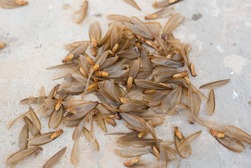Termites are infamous for their destructive capabilities, often causing significant structural damage to homes and buildings without immediate detection. Within the diverse termite colony, flying termites play a crucial role in the proliferation of their species. In this article, learn more about flying termites, what they look like, why flying termites suddenly appear, and how to get rid of them.
What Do Flying Termites Look Like?
The appearance of flying termites, or alates, is marked by several distinct features. They possess two pairs of long, delicate wings that stack on top of each other and are of equal length, which is a key characteristic differentiating them from ants. Their bodies are comprised of two segments with a straight waistline, and they have straight antennae. These termites are slightly larger than their non-flying counterparts and can often be seen in a light brown or translucent color.
Known in entomological terms as alates, flying termites are commonly referred to as swarmers. This term aptly describes their behavior during certain seasons when they take flight in large numbers.
Difference Between Flying Termites and Normal Termites
Flying termites differ from worker and soldier termites not only in function but also in form. Worker and soldier termites lack wings and are tasked with foraging and defending the colony, respectively. Their bodies are more robust and opaque than the more slender and sometimes semi-transparent swarmers, whose sole purpose is to leave their current colonies, mate, and establish new colonies.
Why Do They Suddenly Appear?
The sudden emergence of flying termites is typically associated with conducive breeding conditions, primarily dictated by the weather. These conditions include warm temperatures and high humidity, usually after rain. The termites emerge en masse to maximize the chances of finding a mate and successfully founding new colonies.
Signs of a Termite Swarm
A termite swarm can be identified by several signs. The most obvious is the sighting of numerous winged termites emerging from woodwork, soil, or other nest locations. Shortly after their flight, these termites shed their wings, so piles of discarded wings near windows, doors, or other entry points are a telltale sign. Occasionally, the bodies of swarmers may be found if they have succumbed to environmental stresses or have failed to find suitable conditions for their new colonies.

Why Do Termites Swarm?
Swarming is a natural phase in a termite’s life cycle geared towards reproduction and dispersal. By swarming, termites ensure genetic diversity and the continued survival of their species by spreading out and establishing new colonies over a wider area.
When?
Termites tend to swarm during specific seasons and under favorable weather conditions. Although spring is the most common time for termites to swarm due to the typically mild and moist conditions following winter, the exact timing can vary significantly based on the local climate and termite species.
For How Long?
While a termite swarm can seem like an enduring event, individual swarms are brief, lasting approximately half an hour to an hour. Nevertheless, if environmental conditions remain suitable, multiple swarms can happen over days or even weeks.

How to Get Rid of Flying Termites
Eliminating flying termites involves several steps:
- Moisture Control: Reduce humidity levels and rectify any water leaks in your home.
- Sealing Entry Points: Seal gaps around utility lines and cracks in your foundation to prevent entry.
- Proper Ventilation: Maintain good airflow in attics, basements, and crawl spaces to discourage termite habitation.
- Traps and Zappers: Use commercially available traps or electric zappers to catch and kill flying termites.
- Chemical Treatments: Employ termiticides which are specialized insecticides formulated to kill termites, ideally applied by professionals.
Termites
Now that you know why flying termites suddenly appear, it is time to learn about other termite information that may be useful. One of those is what eats termites. Termites are a delicacy for birds, insects, mammals, reptiles, and other amphibians.
Another thing you should know about termites is what attracts them. Termites love moisture, wood, and foundation. They also love untreated wood and any entryway into the home.
When to Call a Professional
Expert intervention is advised when you notice substantial signs of a termite infestation, such as large numbers of flying termites, structural wood damage, or mud tubes. Pest control professionals can correctly identify the extent of the problem and provide effective treatment plans.
Here is a great video to check out so you know if you have flying termites.
Conclusion
Flying termites tend to suddenly appear and serve as a critical warning sign of potential termite infestation. By understanding their appearance, behaviors, and seasonal patterns, homeowners can take proactive measures to monitor and prevent extensive damage caused by these insects. Timely action, backed by professional help when necessary, is the best strategy to safeguard your property against the silent threat termites bring. Reach out to AAA Pest Control to get termites and other pest issues under control in Oakland Park, FL, and the surrounding South Florida areas.

